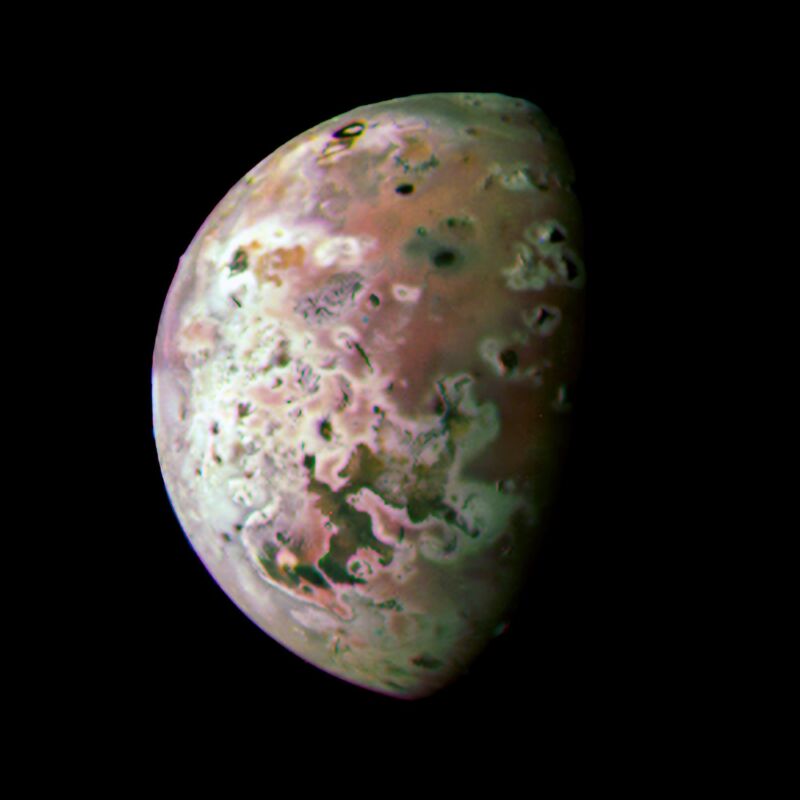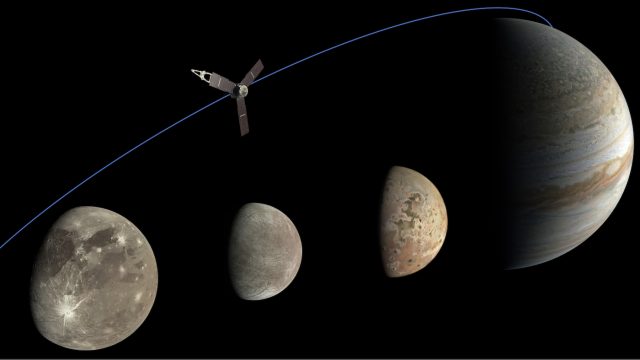
The last time a spacecraft got this close to Jupiter's moon Io was more than 20 years ago, a blink of an eye on a typical geological timescale. Most planetary bodies in our Solar System wouldn't exhibit so much change in a couple of decades.
But Io is different, with volcanic eruptions regularly remaking parts of the moon's crust. That means there's a good chance something on Io has changed since NASA's Galileo orbiter last encountered it in 2002.
NASA's robotic Juno spacecraft is delivering the fresh data on Io with a series of flybys, each getting closer to Jupiter's volcanic moon until a pair of close-up encounters at a range of less than 1,000 miles (about 1,500 kilometers) in December and February.
The most recent flyby on July 30 brought the solar-powered Juno probe about 13,700 miles (22,000 kilometers) from Io's tortured surface. Juno's science instruments were active for the flyby, with the spacecraft's infrared mapping instrument tuned to detect heat signatures from volcanic eruptions and lava flows and an optical imaging camera taking long-range pictures of Io.
The $1.1 billion Juno mission launched 12 years ago this week and arrived in orbit around Jupiter on July 4, 2016. Its original goal was to study Jupiter's atmosphere and deep interior. One of its top science results was finding evidence for a large, potentially dissolved core inside Jupiter, upending a hypothesis that Jupiter had a smaller, solid core at its center.

Juno is now on an extended mission, and scientists cast a wider net of science observations for the spacecraft's second act. The tug of gravity from Jupiter is naturally changing Juno's orbit over time, bringing the spacecraft across the paths of the giant planet's largest moons. Juno flew close to Jupiter's largest moon, Ganymede, in 2021 and then visited Europa for a fleeting encounter in September 2022.
Io, slightly larger than Earth's Moon, will get the most sustained look from Juno, which started long-distance observations of the volcanic moon last year. In May, Juno flew less than 22,000 miles (35,000 kilometers) from Io, followed by the closer flyby on July 30. The spacecraft will see Io again in October before setting up for what Juno's lead scientist, Scott Bolton, calls the "climax" of the campaign—the 1,500-kilometer flybys set for December 30 and February 3.
Some things never change
While Io is noteworthy for its constant changes, scientists are finding at least one consistency about Io: an apparently continually erupting volcano called Prometheus, also dubbed the "Old Faithful of Io."
NASA's Voyager spacecraft first detected the volcano in 1979, and the Galileo orbiter made numerous observations of Prometheus during its eight-year tour of the Jupiter system from 1995 through 2003. The Pluto-bound New Horizons probe also saw the volcano erupting in 2007.
Juno has shown that the volcano is still going, spewing a plume of gas and dust high above the night side of Io.
Io is the most volcanically active body in the Solar System. The gravitational pull from Jupiter and the moons Ganymede and Europa are stretching Io, generating tidal forces that generate heat and trigger volcanic eruptions.
For comparison, Io's solid surface bulges by as much as 330 feet (100 meters) during each tidal cycle, according to NASA. The most extreme tides on Earth—in liquid water—vary about 60 feet (18 meters).
During Juno's May flyby with Io, the spacecraft's camera captured a view of a region of Io called Volund. There are changes afoot here.
“When I compared it to visible-light images taken of the same area during Galileo and New Horizons flybys (in 1999 and 2007), I was excited to see changes at Volund, where the lava flow field had expanded to the west and another volcano just north of Volund had fresh lava flows surrounding it,” said Jason Perry of the University of Arizona’s HiRISE Operations Center in Tucson. “Io is known for its extreme volcanic activity, but after 16 years, it is so nice to see these changes up close again."
Scientists have proposed sending a dedicated spacecraft to systematically study Io, similar to the way NASA's Europa Clipper mission set for launch next year will provide a closer look at the icy moon thought to be one of the Solar System's most promising locations for finding possible life.
But NASA has not approved an Io mission. That means Juno's observations in the coming months will probably yield the only close views of Io for at least the next decade.



3175x175(CURRENT).thumb.jpg.b05acc060982b36f5891ba728e6d953c.jpg)
Recommended Comments
There are no comments to display.
Join the conversation
You can post now and register later. If you have an account, sign in now to post with your account.
Note: Your post will require moderator approval before it will be visible.